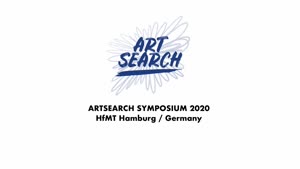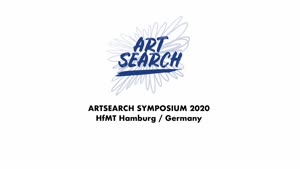Artistic Research - DAY 2 - HfMT Videoteam - HfMT
- MEDIATHEK
- Alle Videos
- HfMT
- HfMT
- ArtSearch Symposium 2020
Alle Videos
2494 Aufrufe
01.02.2020
Artistic Research - DAY 2
Theodore Lee Parker
Integrating cognitive science perspectives while pursuing an artistic question.
Understanding the mechanisms involved in listening, perceiving, and assigning meaning to sound exist in the sciences as an 9 interdisciplinary grey zone. Our current understanding stretches across several fields with a great deal of unknowns still prevalent in terms of music and general listening culture. However, instead of viewing this lack of understanding as placing restrictions on the creative process, they could be used to provoke, frame, and pursue questions which are artistic in nature. Though there has been a divide placed between the research fields of psychoacoustics, acoustic cognition, acoustic ecology, and general music making activities, the possibility for using the individual perspectives in order to explore our own artistic pursuits could provide interesting research opportunities. In this presentation I will discuss some of the unknowns regarding our listening habits and how these have come up in my own artistic practice. Particularly, I will focus on improvisation and site specific sound phenomenon. The types of questions coming up in my own practice do not attempt to provide answers to such mysteries of listening, but use the unknown to shape and guide the pathway of experimentation. Additionally, a general overview will be discussed regarding what methodological frameworks and historical precedents could be applied towards integrating interdisciplinary sciences into one’s own artistic development.
----
Prof. Henrik Frisk
Challenging machine aesthetics and the musical automation
Departing from the artistic research project Goodbye Intuition(- GI)hosted by the Norwegian Academy of Music in Oslo, this presentation discusses the aesthetics of improvising with machines. Playing with a system such as the one used by GI, with limited intelligence and no real cognitive skills will obviously reveal the weaknesseses of the system, but it will also convey part of the preconditions and aesthetic frameworks that the human improviser brings to the table. If we want the autonomous system to have the same kind of freedom we commonly value in human players’ improvisational practice, are we prepared to accept that it may develop in a direction that departs from our original aesthetical 10 ambitions? The analyses presented here are based on some of the documented interplay between the musicians in the group in workshops and laboratories. The question of what constitutes an ethical relationship in this kind of improvisation is briefly discussed. The aspect of the macines desembodied relation to the music emerges as a central obstacle in the development of musical improvisation with machines.
----
Prof. Dr. Anke Haarmann
Doing as the Art of Research - Anke Haarmann
Research is a practice. So are the procedures of art. Not every artistic practice is research and not every research activity is an artistic procedure. It is necessary to explain what the researcher consists of in some artistic practices. Like rehearsing, discarding, knocking, drawing, arranging, connecting, moving bodies and material in the studios and ateliers. In art, a process is carried out through activity that enables insight. Compositions of actions, understandings and productions form aesthetic artefacts, sceneries and understanding. But how? A ‚close reading‘ of what happens in the processes of making art will be necessary to answer this question.
----
Katt Hernandez
The Ephemeral City: Songs for the Ghost Quarters
"...I am collecting the ashes of the other possible cities that vanish to make room for it, cities that can ever be rebuilt or remembered.” Italo Calvino, Invisible Cities I am constructing an imaginary city, to be met by the imaginary cities of those who listen. It is formed of a group of works about 11 transformation in Stockholm, along with writings on psychogeography, space, place, urban history and activism. In cities where the lockstep demands of franchise environments and globalized real estate have flattened the cityscape into repeatable entities, devoid both of history and alternative futures, how can individuals reclaim or re-imagine their own story of who they are in that place? Reflecting on such questions, I utilize field recordings, large modular synthesizer systems, pipe organs, spoken text, multi-channel speaker arrays, hurdy-gurdies, nyckelharpas and violin – as a metaphor to the architectural gestures and layers of magnitude in Stockholm. It is also a meditation on ghosts, held in places as stories and memory, and a meditation on urban activism. In refuting single-minded messages of economic dominance, it is the gentle, the subtle, and the complex that become subversive, revolutionary –with the power to also re-imagine. Sound is ephemeral, and with it we can construct an ephemeral city. We can create ephemeral space where real space has been altered, and where the remnants of a story have been removed, it‘s re-telling can re-illuminate its place of origin, or futures as yet to be realized.
----
Dr. Benjamin Sprick
Decoding the Virtual – Towards a Kinetic Ontology of Music
When we ask “What is musical movement?” perhaps we are asking the wrong question. This question is problematic, precisely because it demands the acquisition of the essence of that which is embedded within a process of distinguishing itself from itself. Should it come from the sound of a single note, the intensification of the stroke from a cello’s bow, or the timbrematic variation of an expressive voice, musical movement is always on the run, entre deux coupes, shifting inwards. It emerges from the spaces 12 in between and evades the power of the banal philosophical singular which seeks to halt its own excursion through vibrating surfaces, limiting its inherent definitions. Musical movement is a kinetic multitude, it is virtual. When interrogating musical kinesis, we must ask more precise questions about who, to what extent, of how, where, and when? It is only in this way that we can expose its heterogeneous nature. Drawing from Gilles Deleuzes’ Cinema 1: The Movement-Image, the ideas outlined above will be further validated through the use of so-called ‘cellophilosophic’ studies, an approach developed by the author as part of his artistic-research project, Musical Cinematographics.
----
Prof. Dr. Georg Hajdu | Samuel Penderbayne
The Manifesto of the Hamburg School of Artistic Research
… is a living document outlining the principles of artistic research, as seen by the colloquium on artistic research and as moderated and summarised by Samuel Penderbayne. It outlines seven points that define the school’s approach and epistemology, an especially relevant task in the face of the intense and pluralistic current debate on artistic research. Speakers invited to give keynotes at the lecture series on artistic research at the University for Music and Theatre, Hamburg (the “school”) are invited to critique and take a position toward the manifesto. The lecture series runs from the winter semester in 2019 until the winter semester in 2022, inviting six keynote speakers per year. In addition, the manifesto is discussed in detail at monthly seminars at the school and adjusted accordingly by the moderator. The manifesto also acts as a guideline and benchmark for the dissertation program in artistic research in music at the school, Doctor Scientiae Musicae.
----
Open final discussion
Kapitel
-
 00:00:07Theodore Lee Parker - Integrating cognitive science perspectives while pursuing an artistic question.
00:00:07Theodore Lee Parker - Integrating cognitive science perspectives while pursuing an artistic question. -
 00:37:21Prof. Henrik Frisk - Challenging machine aesthetics and the musical automation
00:37:21Prof. Henrik Frisk - Challenging machine aesthetics and the musical automation -
 01:36:35Prof. Dr. Anke Haarmann - Doing as the Art of Research
01:36:35Prof. Dr. Anke Haarmann - Doing as the Art of Research -
 02:21:51Katt Hernandez - The Ephemeral City: Songs for the Ghost Quarters
02:21:51Katt Hernandez - The Ephemeral City: Songs for the Ghost Quarters -
 02:56:24Dr. Benjamin Sprick - Decoding the Virtual – Towards a Kinetic Ontology of Music
02:56:24Dr. Benjamin Sprick - Decoding the Virtual – Towards a Kinetic Ontology of Music -
 03:34:21Prof. Dr. Georg Hajdu | Samuel Penderbayne - The Manifesto of the Hamburg School of Artistic Research
03:34:21Prof. Dr. Georg Hajdu | Samuel Penderbayne - The Manifesto of the Hamburg School of Artistic Research -
 04:36:46Open final discussion
04:36:46Open final discussion







